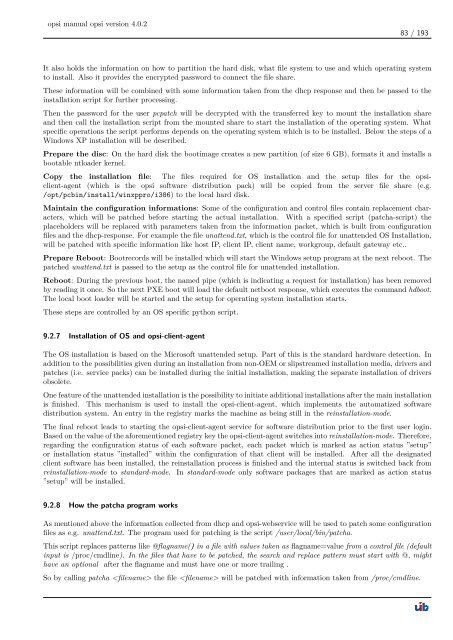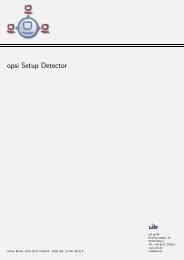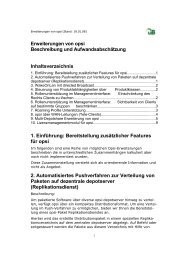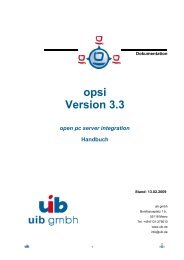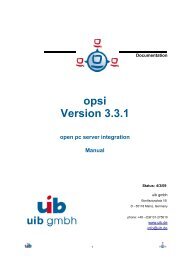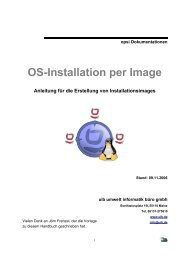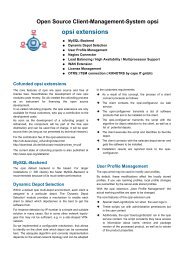opsi manual opsi version 4.0.2 - opsi Download - uib
opsi manual opsi version 4.0.2 - opsi Download - uib
opsi manual opsi version 4.0.2 - opsi Download - uib
Create successful ePaper yourself
Turn your PDF publications into a flip-book with our unique Google optimized e-Paper software.
<strong>opsi</strong> <strong>manual</strong> <strong>opsi</strong> <strong>version</strong> <strong>4.0.2</strong><br />
83 / 193<br />
It also holds the information on how to partition the hard disk, what file system to use and which operating system<br />
to install. Also it provides the encrypted password to connect the file share.<br />
These information will be combined with some information taken from the dhcp response and then be passed to the<br />
installation script for further processing.<br />
Then the password for the user pcpatch will be decrypted with the transferred key to mount the installation share<br />
and then call the installation script from the mounted share to start the installation of the operating system. What<br />
specific operations the script performs depends on the operating system which is to be installed. Below the steps of a<br />
Windows XP installation will be described.<br />
Prepare the disc: On the hard disk the bootimage creates a new partition (of size 6 GB), formats it and installs a<br />
bootable ntloader kernel.<br />
Copy the installation file: The files required for OS installation and the setup files for the <strong>opsi</strong>client-agent<br />
(which is the <strong>opsi</strong> software distribution pack) will be copied from the server file share (e.g.<br />
/opt/pcbin/install/winxppro/i386) to the local hard disk.<br />
Maintain the configuration informations: Some of the configuration and control files contain replacement characters,<br />
which will be patched before starting the actual installation. With a specified script (patcha-script) the<br />
placeholders will be replaced with parameters taken from the information packet, which is built from configuration<br />
files and the dhcp-response. For example the file unattend.txt, which is the control file for unattended OS Installation,<br />
will be patched with specific information like host IP, client IP, client name, workgroup, default gateway etc..<br />
Prepare Reboot: Bootrecords will be installed which will start the Windows setup program at the next reboot. The<br />
patched unattend.txt is passed to the setup as the control file for unattended installation.<br />
Reboot: During the previous boot, the named pipe (which is indicating a request for installation) has been removed<br />
by reading it once. So the next PXE boot will load the default netboot response, which executes the command hdboot.<br />
The local boot loader will be started and the setup for operating system installation starts.<br />
These steps are controlled by an OS specific python script.<br />
9.2.7 Installation of OS and <strong>opsi</strong>-client-agent<br />
The OS installation is based on the Microsoft unattended setup. Part of this is the standard hardware detection. In<br />
addition to the possibilities given during an installation from non-OEM or slipstreamed installation media, drivers and<br />
patches (i.e. service packs) can be installed during the initial installation, making the separate installation of drivers<br />
obsolete.<br />
One feature of the unattended installation is the possibility to initiate additional installations after the main installation<br />
is finished. This mechanism is used to install the <strong>opsi</strong>-client-agent, which implements the automatized software<br />
distribution system. An entry in the registry marks the machine as being still in the reinstallation-mode.<br />
The final reboot leads to starting the <strong>opsi</strong>-client-agent service for software distribution prior to the first user login.<br />
Based on the value of the aforementioned registry key the <strong>opsi</strong>-client-agent switches into reinstallation-mode. Therefore,<br />
regarding the configuration status of each software packet, each packet which is marked as action status ”setup”<br />
or installation status ”installed” within the configuration of that client will be installed. After all the designated<br />
client software has been installed, the reinstallation process is finished and the internal status is switched back from<br />
reinstallation-mode to standard-mode. In standard-mode only software packages that are marked as action status<br />
”setup” will be installed.<br />
9.2.8 How the patcha program works<br />
As mentioned above the information collected from dhcp and <strong>opsi</strong>-webservice will be used to patch some configuration<br />
files as e.g. unattend.txt. The program used for patching is the script /user/local/bin/patcha.<br />
This script replaces patterns like @flagname() in a file with values taken as flagname=value from a control file (default<br />
input is /proc/cmdline). In the files that have to be patched, the search and replace pattern must start with @, might<br />
have an optional after the flagname and must have one or more trailing .<br />
So by calling patcha the file will be patched with information taken from /proc/cmdline.


